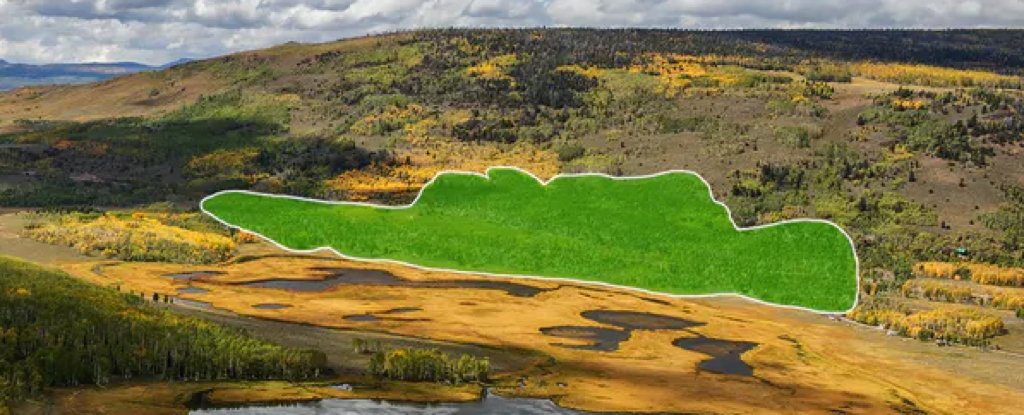We are now able to perceive the auditory signals emitted by one of the most extensive and ancient living organisms on our planet, as it softly resonates through the vibrations of countless leaves reverberating along its intricate network of roots.
Pando, the name derived from the Latin term for "I spread," is a forest composed of a solitary tree. It spans over 100 acres (40 hectares) of land in Utah and boasts an astonishing 47,000 stems, all possessing identical DNA and originating from a shared root system.
This towering specimen, identified as a male quaking aspen (Populus tremuloides), has gradually expanded to an immense mass of 6,000 metric tons over the course of its potentially 12,000-year existence. Consequently, it holds the prestigious title of being the largest living organism in the world in terms of sheer weight.
Given its extensive lifespan and colossal size, this extraordinary plant undoubtedly harbors a wealth of knowledge. Recently released recordings allow us to experience its expressions in an unprecedented manner.
"The discoveries are highly intriguing," remarked Lance Oditt, the founder of Friends of Pando, during the project's unveiling in May.
"While originally conceived as an artistic endeavor, we perceive immense potential for scientific applications. By translating wind-induced vibrations, which manifest as audible sounds, traveling through the interconnected root system, we may uncover the enigmatic inner workings of Pando's vast and concealed hydraulic network in a non-destructive manner."
Jeff Rice, a sound artist, embarked on an experimental endeavor by placing a hydrophone within a cavity at the base of a branch and carefully guiding it towards the tree's roots. Initially, he did not anticipate noteworthy results.
"It is important to note that hydrophones are not solely reliant on water for functionality," Rice explained. "They can also capture vibrations from surfaces such as roots. When I put on my headphones, I was immediately taken aback by what I heard. Something extraordinary was transpiring. There was a faint auditory presence."
During a thunderstorm, the recorded sounds became more pronounced, capturing an eerie and low rumbling.
"I believe that what we are hearing is the collective resonance of millions of leaves within the forest, as they set the tree in motion and transmit vibrations throughout the branches and deep into the soil," Rice elucidated when he presented his recordings at the 184th Meeting of the Acoustical Society of America, as reported by The Guardian.
The hydrophone also managed to capture the distinct thuds produced by tapping a branch situated 90 feet away, despite the fact that the sound was not discernible through the air at such a distance. This observation lends support to the notion that Pando's root system is interconnected, although a meticulous experimental setup would be required to definitively confirm that the sound was not propagated through the soil.
While shared root systems are commonplace among colonial quaking aspens, the size and age of Pando render it a truly unique phenomenon. Although quaking aspens can theoretically reproduce through seeds, this process is seldom observed due to infrequent pollination, as large aspen stands typically consist of a single gender, being clones of a singular individual.
Having recognized the peculiarity and magnitude of Pando, Friends of Pando extended an invitation to Rice, inviting him to serve as an artist in residence, with the aim of gaining a deeper understanding of this remarkable and colossal entity. Oditt aspires to employ sound as a tool for mapping the intricate web of roots that comprise Pando.
"The aesthetic qualities of the sounds are exquisite and intriguing. However, when considering practical implications, it becomes apparent that natural sounds possess the capacity to serve as valuable tools in documenting the state of an environment," asserted Rice. "These sounds serve as a testament to the local biodiversity and establish a fundamental reference point against which environmental changes can be assessed."
In addition, Rice meticulously documented the foliage, bark, and the encompassing ecosystem of Pando.
Oditt articulated, "Friends of Pando intends to employ the collected data as a foundation for further investigations pertaining to water dynamics, interrelationships among branch arrays, insect colonies, and root depth. These topics remain relatively unexplored in present times."
Regrettably, this magnificent arboreal specimen is undergoing a process of deterioration, raising concerns among researchers regarding the limited remaining lifespan of Pando and the entire ecosystem it sustains. Human activities, such as deforestation and the elimination of predator populations that regulate herbivore numbers, contribute to the gradual erosion of this ancient entity.
Thus, it becomes even more imperative to seize the opportunity to listen to 'The Trembling Giant' while there is still a chance to access its enigmatic revelations.
The auditory records were formally presented at the 184th Assembly of the Acoustical Society of America.
A previously published rendition of this article appeared in May 2023.

0 Comments